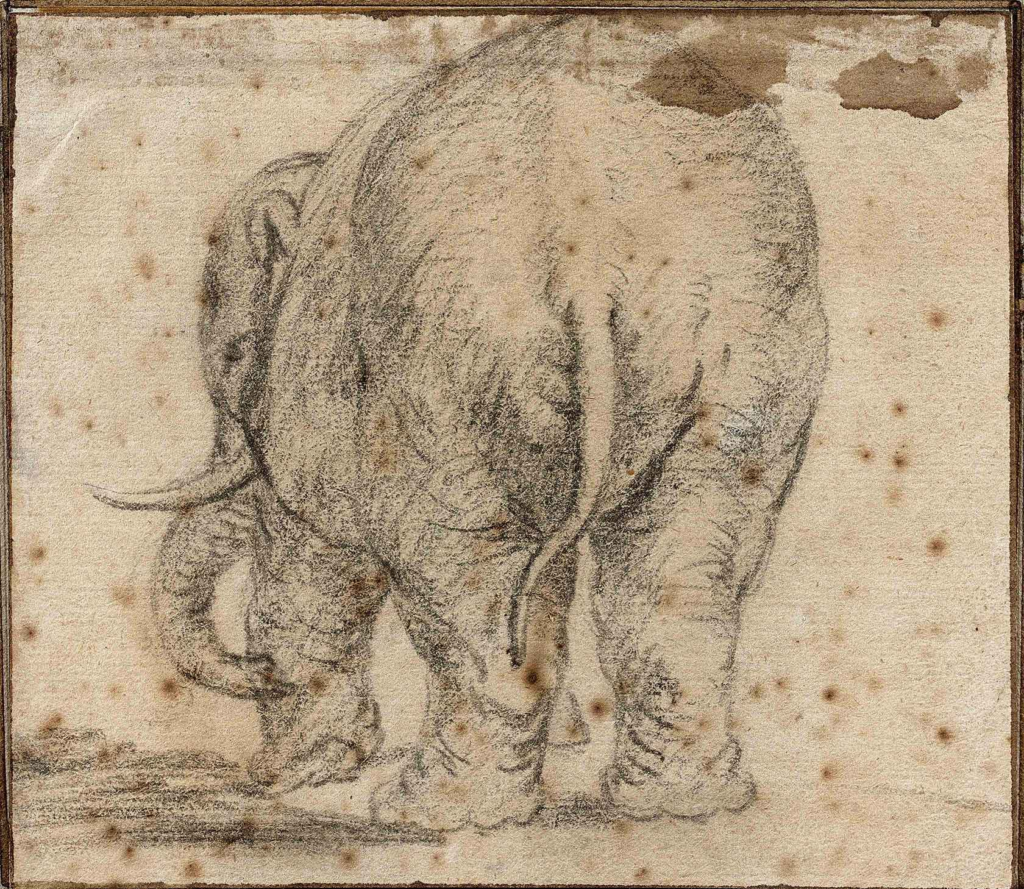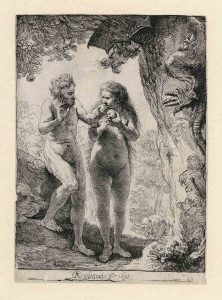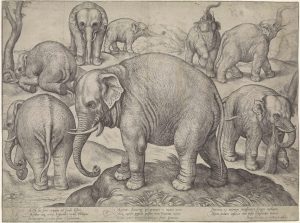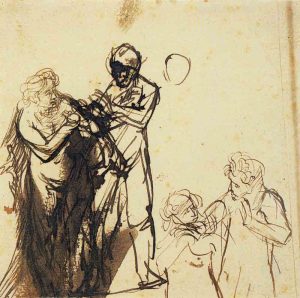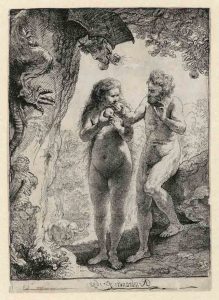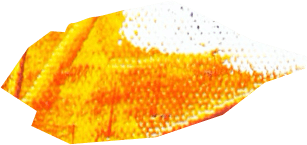Hansken is the most famous elephant of the seventeenth century, partly thanks to Rembrandt, who drew her on several occasions. But there is much more material that gives insight into her life: prints, news reports, written sources, and even her skeleton.1 In the summer of 2021 a selection of these objects went on view at the Rembrandt House Museum, in the exhibition Hansken, Rembrandt’s Elephant. One recently discovered object that originally seemed to be related to Hansken did not make it into the final exhibition selection but merits a separate elucidation. It concerns a drawing of an elephant looking at its buttocks. Further research has shed new light on how this specific sheet was created. This article takes a closer look at the question.
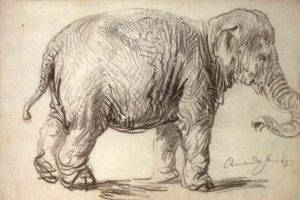
Drawing animals “from life”
Drawing based on direct perception was a must for seventeenth-century artists, not only during their training but also in conducting their profession.2 By for example studying animals in real life they learned how to depict them accurately and convincingly. This practice is not only evident from the many artist’s sketches of animals that have been preserved but also from written advice to artists, such as published by Willem Goeree in 1670 “one should especially make sure to seize opportunities when it comes to rarities, such as lions, tigers, bears, elephants, camels and such kinds of wild animals, which one seldomly gets to see with one’s own eyes, and sometimes needs to have seen in order to incorporate them into one’s inventions”.3
Rembrandt too made sketches of animals based on his own observations.4 Exotic animals when he had the chance but also dogs, horses, cows and pigs. These drawings formed part of an extensive collection of study material – autograph drawings and prints as well as numerous works on paper by other artists – that Rembrandt kept in his art cabinet. The inventory of Rembrandt’s collection from 1656 mentions among other items in this room “one ditto (Chinese basket) full of drawings by Rembrandt being animals after life.”5
There are various Rembrandtesque sketches of lions, dating to different periods. A number of these are attributed to Rembrandt.6 Others have been identified as by the hand of (anonymous) pupils. Lions and other animals appeared regularly at the Amsterdam fair.7 Evidently, Rembrandt took his pupils along to such events. Did this also happen when Hansken was in Amsterdam? From Rembrandt’s hand there are at least three known drawings of Hansken (including fig. 1).8 A fourth, in a New York collection, is not accepted by all Rembrandt drawing specialists as autograph.9 Could a highly competent pupil have made the sketch? Spontaneity and very specific observations characterize these four sketches as the product of live drawing sessions with Hansken as model.
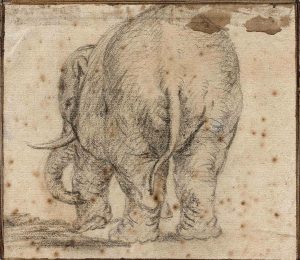
In the leadup to the exhibition, Rembrandt drawings scholar Peter Schatborn pointed out an unpublished drawing in a French private collection, of an elephant seen from behind (fig. 2).10 In the report that he had prepared for the owners he identified the sketch as a product of a drawing session after life.11 Perhaps even carried out at the Amsterdam fair in September 1637, while Rembrandt was making his first drawings of Hansken (fig. 1). The style of the drawing is closely related to the manner in which Rembrandt drew at the end of the 1630s. And just like Rembrandt’s sketch of Hansken it is executed in black chalk. But on account of the less skilled drawing hand Peter Schatborn identified the maker as an (anonymous) pupil of Rembrandt.
A physical characteristic of the paper on which the drawing was made supports this analysis: it bears a watermark (foolscap) that mainly occurs in paper from the second half of the seventeenth century.12 The identification of the draughtsman as someone from the circle around Rembrandt is very convincing, as is the dating of the sheet. And on first glance the suggestion that the artist joined Rembrandt in sitting around the elephant Hansken drawing seems believable. But herein we stumble upon a problem: the tusk that has been included. Female Asian elephants namely do not have such tusks, and also not Hansken.13 It is also highly unlikely that this kind of detail would have been added to a sketch after life. But how must we then explain this drawing?
The Buttocks of a Male Elephant
Hansken was a major attraction and many went to admire her. This may have put Rembrandt in mind to include her in an etching. A year after Rembrandt drew Hansken for the first time, he incorporated an elephant into a representation of Adam and Eve in Paradise, at the point of committing the great sin of their lives (fig. 3). It is the only instance of an elephant in a narrative scene by Rembrandt’s hand.
The earliest purchasers of this print will undoubtedly have drawn the link between the elephant in the background and the animal that just previously had been on view in Amsterdam.14 In this way Rembrandt’s print served as a visual reminder of a rare event. Rembrandt hereby, in a subtle way, joined an established tradition. Commemorative prints had namely been made of elephants that previously been in Europe.15 One of these proves to be crucial to understanding the drawing of the elephant’s buttocks.
On 24 September 1563 a live Asian elephant went on display in Antwerp. The animal was given the name Emanuel.16 The etcher Gerard van Groeningen (Paludanus, active between c. 1561 and 1576) produced a commemorative print of the animal in that year or shortly thereafter (fig. 4).17 There the elephant concerned is represented in eight different poses, set in a fantasy mountainous landscape.
To the left Emanuel appears from behind; in the same pose and direction as in the French drawing and with a tusk (fig. 5). Although the dimensions of the elephant in the drawing digress somewhat from the printed one, and details vary somewhat from the etched elephant – the trunk has a simplified form and the tail hangs slightly differently – it is very likely that this figure served as model for the draughtsman.
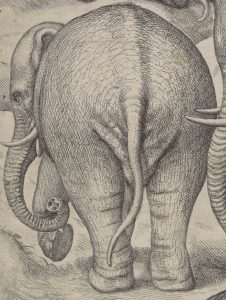 |
 |
The anonymous artist clearly worked from a printed, and not from a living model. In light of the similarities and differences with the print by Van Groeningen, the motif was freely – and thereby not very precisely – copied. Such a method fit with current practice: over the course of their working lives artists worked from prints and other works of art, as well as from life. In order to develop and maintain their drawing skill but also to research and practice with motifs.
If the drawing of the elephant buttocks was made by a pupil of Rembrandt, then he would have had access to the print. Did Rembrandt perhaps own an impression? An observation of one of Rembrandt’s autograph drawings of Hansken could possibly support this hypothesis.
Van Groeningen’s print shows, according to the Latin inscription, how an elephant is able to move its legs. In older texts it was asserted that elephants could not kneel because they did not possess knee joints. By way of observations from the live elephant Emanuel this assumption could be waylaid. But, by showing Emanuel in various positions, and in an imaginary landscape, Van Groeningen suggests that Emanuel was part of a herd.
It was quite common for artists to combine multiple views of the same subject in one scene or sheet of sketches. Rembrandt did this as well in a drawing of Hansken. After his earliest representations of Hansken, Rembrandt observed and drew her again, probably in 1641 (fig. 7).18 This time he depicted the elephant in three different poses: while she stands, eats, and lies on the ground. In the process, Rembrandt fused his sketches, giving the suggestion of a herd of elephants.
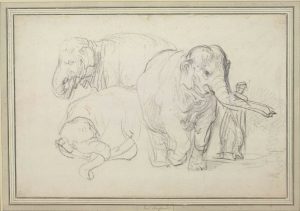
Emanuel and Hansken were, at the moments that they were in Europe, the only living elephants on the European continent. And although there was little known about elephants, it was told in older and contemporary sources that they lived in herds.19 Hansken’s owner Cornelis van Groenevelt also shared information with spectators who posed questions. The print of the Antwerp elephant may have served as visual inspiration for Rembrandt to present his observations of Hansken with the suggestion of a small herd.
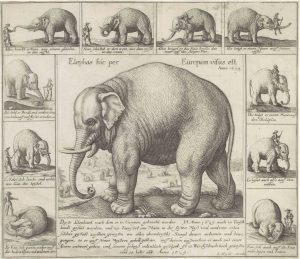
Elephants on a small scale
At any rate, the etching by Van Groeningen must have enjoyed some fame, as it inspired various artists. Between 1581 and 1600 an anonymous artist took over the eight elephant views in a book on animals that was published in Antwerp or Amsterdam.20 And in 1629 the Bohemian artist Wenceslaus Hollar (1607-1677) took them as a model.
Hollar etched the illustrations for a publicity print for another male elephant. That animal was in Europe shortly before Hansken and bore the name Don Diego.21 In this publicity print there is a main scene framed by a series of depictions of the tricks that the animal performed (fig. 8). When we zoom in on the main scene it is evident how much it is based on the print by Van Groeningen (fig. 9). In the centre an elephant stands in profile in a fantasy landscape. Around that animal other elephants can be seen, in very small scale, as if they are far away in the landscape. All of these elephants are copied from the print by Van Groeningen.
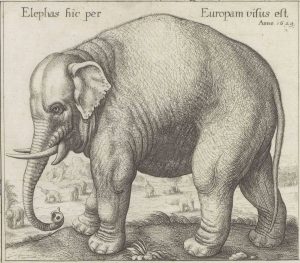
The reversed pose confirms the relationship for the small elephants: the copied figures ended up in mirror image on the paper as a result of the printing process. Among the small elephants is one seen from behind, this time with the head and trunk turned to the right. Because of the direction and the difference in scale it is not likely that the pupil of Rembrandt took Hollar’s print of 1629 as his model for his drawing. But it is in turn not impossible that Rembrandt knew this print as well, or even owned it since Rembrandt was an admirer of Hollar. In 1656 he owned several of his prints.22
The print of Don Diego could have provided Rembrandt with inspiration, for his abovementioned etching of Adam and Eve. There he chose to represent the elephant in a very small scale, far away, where she comes walking in a hollow (fig. 10). In his first encounter with Hansken, it would have been her large scale that would have made an impression.
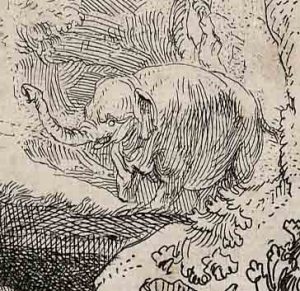
Would he have known beforehand that he was going to see a large animal? He took along with him a large sheet of paper to the city centre to record her, but did not entirely succeed given the correction he made to the trunk, in order to keep it inside the pictorial frame.
But Rembrandt could also have come up with the idea of a small elephant via another route: from the prints of the Italian artist Antonio Tempesta (1555-1630). Rembrandt admired his work as well and took it as a model, already early in his career.23 At his insolvency he owned multiple art books filled with Tempesta’s graphic work.24
One of the larger etchings in his oeuvre is the ‘Aetas Aurea’, The Golden Age, of 1599 (fig. 11). It shows a paradisiacal world in which humanity and animals peacefully coexist. In the background a small elephant boisterously raises its trunk (fig. 12). The same motif appears in several prints by Tempesta.25
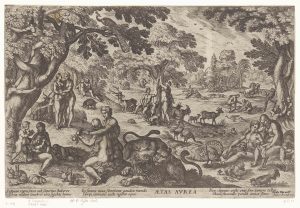
It is therefore likely that Rembrandt was already familiar with the motif when he started working on his etching of Adam and Eve.
It was said of elephants that they greet the sun out of divine intuition. Rembrandt possibly knew such folklore and wanted to incorporate it in his narrative scene filled with symbolism.26 The pose of the elephant in his etching is not a literal quotation, but rather a free interpretation by Rembrandt of depictions of elephants by other artists and from his own memory.
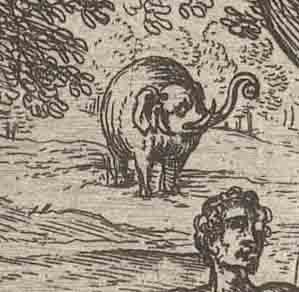
As long as it is “after life”
In his work Rembrandt relied on his own observations, but also those of others. By bringing together an enormous collections of prints by artists he admired he created an extensive image bank for himself and his pupils. And among these he kept his sketches. On the basis of all these works on paper he could draw inspiration and consult visual material. In this way working from nature and from art went hand in hand. Certainly when such printed examples were themselves made after life.
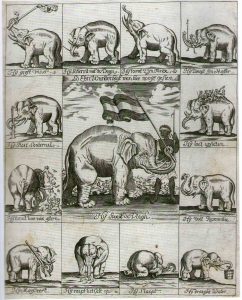
The inventory of Rembrandt’s possessions of 1656 shows how both of these forms coexisted: besides his own autograph paintings and drawings of landscapes, people and animals there are multiple works by other artists explicitly cited as having been made after life: “een moor nae ’t leven afgegooten“ (a Moor cast from life), “agt stuck pleysterwerck op ’t leven afgegoten” (eight plaster casts from life) and “een leeuw en een bul op ’t leven gebouceert” (a lion and a bull rendered from life). Elsewhere in Rembrandt’s house are mentioned “drie hondekens nae ’t leven van Titus van Rijn” (three “doggies” after life by Titus van Rijn) and “een vissie nae ’t leven” (a fish after life).27 The knowledge that these objects provided an accurate image of the things represented was evidently important to indicate.28
It is partly for this reason that the print by Gerard van Groeningen would have been reused. It must have been seen, on account of its detail and variation – recorded by Van Groeningen on the basis of his own observations – as a trustworthy source. Especially in a time when there were very few other true-to-life images of elephants available.
As much as a century later Van Groeningen’s print served as model – directly, or indirectly via the print of Don Diego – for the commemorative print of a female elephant that made the next trek through Europe after Hansken (fig. 13).29 For several poses the maker of this print based himself on figures that can be traced back to Van Groeningen’s print.
The motif of the elephant’s buttocks is also used there: this time elaborated into a scene in which the animal shows its behind while swinging people through the air. In the caption it is suggested that the display of its buttocks was one of the tricks that the elephant performed. If she swung people through the air at the same time, is highly questionable. At any rate she would not have used tusks, as she also did not have them.30 And just like in the French drawing, we are looking here at an image of the male elephant Emanuel that journeyed through Europe a century earlier.
Hybrid practice
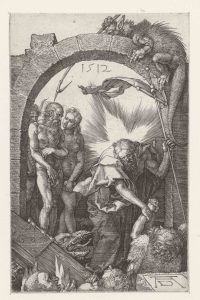
We have sketched above a practice in which artists based themselves equally readily on printed models even when they could go and see and study an animal in real life. Rembrandt’s small etched elephant also seems to witness to this approach. But his print of Adam and Eve is in many respects an example of a hybrid artistic practice.
Rembrandt must have been aware not only of prints of elephants in circulation, but also ones of dragons. Between 9 and 13 February 1638, he purchased various prints by Albrecht Dürer from the collection of Gommer Spranger.31 Christ in Limbo must have been among them (fig. 14).32 There the devil appears in the guise of a dragon. The similar in pose of the dragon in Rembrandt’s etching is often seen as conscious borrowing by Rembrandt from the German artist he greatly admired.
For a fantastic beast such as a dragon Rembrandt leaned on the powers of imagination of his illustrious predecessor. But on his own Rembrandt sought out the correct poses and interaction of the two main figures (fig. 15 and 16).33 Perhaps with the use of models, and thus “after life”. Here he chose – against all conventions – to render Adam and Eve not with ideal beauty but as common, realistic people. The result of all of these forms of inspiration was a scene rich in significance, with many references to myths and stories, and a female elephant that had just previously been in Amsterdam.34
- See www.elephanthansken.com for a current collection of all the traces left by Hansken and her owner, brought together thanks to the research of Michiel Roscam Abbing. In 2016 M. Roscam Abbing, Rembrandts olifant. In het spoor van Hansken appeared, followed in 2021 by an updated edition in English translation entitled Rembrandt’s Elephant. Following in Hansken’s Footsteps, both with Leporello in Amsterdam.
- In Het Schilder-boeck of 1604 (Haarlem) Karel van Mander calls drawing the father of all of the arts. Constant practice, especially taking everything that nature offers as model, will make the artist successful; see fol. 8r+v, Van het teyckenen, oft Teycken-const. Tweede Capittel.
- W. Goeree, Inleydingh Tot de Praktijck Der Al-gemeene Schilder-Konst, Middelburg 1670, p. 121.
- For an overview see P. Schatborn, E. Hinterding, Rembrandt. Alle tekeningen en etsen, Cologne 2019, pp. 285-301.
- No. 249 in the inventory, see document/remdoc/e12724. For more background on Rembrandt’s collection, see B. Broos e.a., Rembrandt’s Treasures, Amsterdam 1999.
- Peter Schatborn accepts six lion drawings as autograph: Rembrandt, A Lioness or Young Lion with Prey (a Bird), Reclining, with Head to the Left, 1637-1641. Charcoal and wash, with white highlights, on prepared paper, 126 x 239 mm. London, British Museum, inv. no. Oo,9.71; Rembrandt, Reclining Lioness or Young Lion, with Head to the Right, 1637-1641. Charcoal and wash, with white highlights, on prepared paper, 125 x 180 mm. London, British Museum, inv. no. Oo,9.75; Rembrandt, Reclining Lioness or Young Lion, from the Front, 1637-1641. Charcoal and wash, with white highlights, on prepared paper, 115 x 150 mm. New York, The Leiden Collection, inv. no. RR-100; Rembrandt, Reclining Lion with Prey, c. 1650. Pen and brush in ink, brush in white paint, with traced contours, 140 x 203 mm. Rotterdam, Museum Boijmans Van Beuningen, Collection Franz Koenigs, inv. no. R 12; Rembrandt, Reclining Lion, c. 1650. Pen and brush in ink, 138 x 207 mm. Paris, Musée du Louvre, inv. no. RF4721; Rembrandt, Reclining Lion, c. 1660. Pen in brown on prepared paper, 122 x 212 mm. Amsterdam, Rijksmuseum, inv. no. RP-T-1901-A-4524.
- For lions, see M. Roscam Abbing, P. Tuynman, “Rembrandts drawings of the elephant Hansken”, in M. Roscam Abbing (ed.), Rembrandt 2006: Essays, Leiden 2006, pp. 173-189, p. 189.
- Rembrandt, Young Asian Elephant (Hansken), 1637. Black chalk, 233 x 354 mm. Vienna, Albertina, inv. no. 17558; Rembrandt, Asian Elephant (Hansken) in three different poses with steward. Black chalk, 239 x 354 mm. Vienna, Albertina, inv. no. 8900; Rembrandt, Asian Elephant (Hansken) with Spectators. Black chalk and charcoal, 179 x 256 mm. London, British Museum, inv. no. Gg,2.259.
- Rembrandt or pupil, Asian Elephant (Hansken), c. 1637. Black chalk and graphite, counterproof. 194 x 189 mm. New York, The Morgan Library & Museum, inv. no. I, 205.
- The drawing has in the meantime been published in M. Roscam Abbing, Rembrandt’s Elephant (see note 1), pp. 22-23. The interpretation of the drawing there is based on the research presented in this article.
- In the possession of Peter Schatborn, the owners of the drawing, and the author of this article.
- There is no available image of the watermark, so further identification is not possible at the moment.
- Female Asian elephants generally do not have tusks. But where present, they do not grow to longer than 10 cm, which does render them visible between the folds of the skin. Hansken had short visible tusks of this kind. Her skeleton, which was preserved after her death in 1655, and is kept on display at the natural history museum La Specola, shows evidence of this: the skull shows the stumps of tusks. The English traveller and writer wrote in 1641 in his diary: “his teeth were but short being a female, and not old, as they told us”. Zie E.S. de Beer (red.), The diary of John Evelyn, Vol. 2. In the same year Ernst Brinck observed: “zijn naar buiten uitstekende slagtanden waren nog maar weinig meer dan een vinger lang” (his protruding tusks were only a little more than a finger long). See also Roscam Abbing and Tuynman, “Rembrandt’s Drawings…” (see note 7), pp. 173-189. There it is explained how in 1633 Hansken’s tusks were not yet visible. In 1641 they were, according to the description of Evelyn and Brinck. They may have been broken off after then, not subsequently growing long enough to be visible.
- Roscam Abbing and Tuynman, “Rembrandt’s Drawings…” (see note 7), p. 184 and Roscam Abbing, Rembrandt’s Elephant (see note 1), pp. 24-25.
- Jan Mollijns, Commemorative Print of the Asian Elephant Emanuel, 1563. Hand coloured woodcut, 285 x 400 mm. London, The British Museum, inv. no. 1928,0310.97, https://www.britishmuseum.org/collection/object/P_1928-0310-97; Gerard van Groeningen, Commemorative Print of the Asian Elephant Emanuel, in Eight Different Poses, in or after 1563. Etching, 405 x 541 mm. Amsterdam, Rijksmuseum, inv. no. RP-P-OB-59.019; Wenceslaus Hollar (after Gerard van Groeningen), Commemorative Print of the Asian Elephant Don Diego, 1629. Etching, 245 x 283 mm. Amsterdam, Rijksmuseum, inv. no. RP-P-1976-16.
- See Chronycke van Antwerpe sedert het jaer 1500 tot 1575. Gevolgd van Eene beschryving van de historie en het landt van Brabant, sedert het jaer 51 vóór J.-C., tot 1565 na J.-C., volgens een onuitgegeven handschrift van de XVIe eeuw, edition of 1843, Antwerp, p. 59: “(…) anno 1563, int eynde van september, doen quam tot Antwerpen tschepe eenen olifant vuyt Portugael, off daer ontrent, oudt by de negen jaeren, hooge acht voeten; desen ginck sdaechs achter straeten dattet een yegelyck sien moechte: desen was seer tam ende wert geregeert van eenen moor doende alwat den moor hem gebiede: desen olifant hiet Emanuel.” (in the year 1563, at the end of September, there came by ship to Antwerp an elephant from Portugal, around nine years old, eight feet tall; it went by day through the streets so that all could see it: it was very tame and was led by a Moor, doing everything the Moor commanded: this elephant was called Emanuel). See e.g. also S. Dackerman, Prints and the Pursuit of Knowledge in Early Modern Europe, New Haven 2011, cat. no. 34.
- See note 15. For the impression in the collection of the Rijksmuseum see http://hdl.handle.net/10934/RM0001.COLLECT.119126.
- Hansken appeared in Amsterdam on four occasions: in the summer months of 1633 and at the fairs (kermissen) of 1637, 1641 and 1647. One of the drawings by Rembrandt can be connected to the fair of 1637, because Rembrandt dated the sheet. Peter Schatborn dates the other two drawings of Hansken by Rembrandt to the same year. However the drawing of Hansen in three poses (Albertina, inv. no. 8900) appears to have been made on a later occasion, in 1641. The animal in that drawing is noticeably older than in the sketch of 1637. See also Roscam Abbing and Tuynman, “Rembrandt’s Drawings…” (see note 7), pp. 173-189. Further research on the paper in the future may yield more information on the dating.
- Up to Rembrandt’s time, there was limited knowledge in Europe concerning elephants. What people thought to know was based on what Pliny the Elder had written in his Natural History (77-79 C.E.). Or on medieval legends such as could be read in the Physiologus, an ancient Greek moralizing text on plants and (mythical) animals. Over the course of time there appeared more and newer editions of these stories. Jacob van Maerlants Der naturen bloeme (c. 1350) is one example, in which the texts are no longer presented in Latin but in Dutch (“Dietsch”). In 1588 Christophel Plantijn in Antwerp published a collection of texts – including the Physiologus – under the title Sancti Patris Nostri Epiphanii, Episcopi Constantiae Cypri, ad Physiologum. Eiusdem in die festo Palmarum sermo. A century later, at the end of the 17th century, the skeleton Hansken, the elephant that died in 1655 in Florence, became accessible to scholars. This led to new insights into the existence of an ancestor species, the mammoth. A Latin description of Hansken’s skeleton by John Ray formed the basis in the 18th century for Carolus Linnaeus’ scientific description of the elephant in terms of its species.
- For the copy of the album in the collection of the Rijksmuseum, see: http://hdl.handle.net/10934/RM0001.COLLECT.353205. For the two prints in its, respectively of five and three elephants, see: http://hdl.handle.net/10934/RM0001.COLLECT.353210 and http://hdl.handle.net/10934/RM0001.COLLECT.353211.
- For the copy in the collection of the Rijksmuseum, see: http://hdl.handle.net/10934/RM0001.COLLECT.33090. Don Diego was in Europe from 1623 to 1635 in Europa. For more information on Don Diego see L. Rice, “Poussin’s Elephant”, Renaissance Quarterly 70 (2017), pp. 548-593; M. Roscam Abbing, “Poussin’s Elephant Revisited”, in Source: Notes in the History of Art 39 (2020), pp. 109-119.
- “Op de kunstcaemer (….) [235] Een Oost-Indies benneken daarin verscheyde prenten van Rembrant, Hollaert, Cocq en andere meer”. See document/remdoc/e12723.
- [i] For his etching of Joseph and the Wife of Potiphar of 1634 (B39/ NHD128) Rembrandt looked to the etching of the same theme by Tempesta, of 1613. And Tempesta’s prints of lion hunts served as model for Rembrandt in his own depictions of the theme, the two small lion hunts of c. 1629 (B115/ NHD28, B116/ NHD29) and his large lion hunt of 1641 (B114/ NHD187). See e.g. B. van den Boogert, J. van der Veen, Dat kan beter! Rembrandt en de oude meesters, Amsterdam 2013, pp. 52-55.
- Nos. 210 – 212 in the inventory. See document/remdoc/e12721 and document/remdoc/e12722.
- See for example in the collection of the Rijksmuseum: God Creates the Animals http://hdl.handle.net/10934/RM0001.COLLECT.183114, Cain Murdering Abel http://hdl.handle.net/10934/RM0001.COLLECT.183148, Orpheus Enchanting the Animals with his Music http://hdl.handle.net/10934/RM0001.COLLECT.183809, Combat of the Centaurs and Various Animals http://hdl.handle.net/10934/RM0001.COLLECT.608702, God Commands Adam And Eve Not To Eat of The Tree of Knowledge http://hdl.handle.net/10934/RM0001.COLLECT.183140.
- See also Roscam Abbing, Rembrandts olifant (see note 1), pp. 22-23; Rembrandt’s Elephant (see note 1), pp. 24-25. Besides the iconography there described of the elephant as a chaste animal, and thereby symbol of humanity before the Fall into Sin, Rembrandt incorporated two myths about elephants. The myth of the mating ritual of elephants refers namely to the sin of the first people in the world. In order to stimulate arousal in the male, the female offers an aphrodisiac. Eve gives the forbidden fruit of the Tree of Knowledge of Good and Evil to Adam, and this fruit in fact serves as an aphrodisiac. Because after eating this fruit they become aware of their desires. And further it was said of elephants and dragons that they were symbols respectively of good and evil, and that they were each other’s greatest enemies. The draco (Latin, translatable as dragon or serpent) hides in a tree, in order to drop down onto an elephant walking by. What follows is a fight to the death, in which both animals perish. Rembrandt also refers to this coming event, as symbol of the struggle between good and evil that will result from Adam and Eve’s fall into sin.
- Respectively nos. 161, 178, 189, 298 and 307 in the inventory, see: document/remdoc/e12719, document/remdoc/e12719, document/remdoc/e12720, document/remdoc/e12727.
- The fact Rembrandt’s insolvency inventory contains such detailed information is one of the reasons to believe that Rembrandt himself dictated how the objects were to be described at the taking of the inventory, on 25 and 26 July 1656.
- For further information on this elephant see: M. Roscam Abbing, “‘So Een Wunder heeft men hier nooijt gesien’ De Indische vrouwtjesolifant (1678/80-1706) van Bartel Verhagen”, Jaarboek Amstelodamum 106 (2014), pp. 68-95.
- The tusks were probably added because they appear in the original print by Van Groeningen and were seen as a typical feature of an elephant. Hansken too was given prominent tusks in some illustrations. In one instance (a drawing from life, but embellished from imagination) it is clear that the artist tried to indicate how tusks would look on her. Stefano della Bella, Elephant (Hansken), with a Black Man. Pen and brush in ink, 128 x 159 mm. Present location unknown (sale,London, Christie’s, 18 March 1975, lot 17). For more on this drawing see: https://www.elephanthansken.com/wp-content/uploads/2013/07/fig.-17.jpg. Around 1647 a publicity or commemorative print of Hansken was also made. For the impression in the Rijksmuseum see http://hdl.handle.net/10934/RM0001.COLLECT.432625. Also in this print, she was mistakenly endowed with tusks, following the example of the print of Don Diego, which also served as model for the arrangement of the print with a central image surrounded by smaller images.
- See document/remdoc/e4447.
- Idem. RemDoc does not supply the detailed list of the works that Rembrandt purchased. The Rembrandt Documents (W. Strauss and M. van der Meulen, New York 1979) does summarize them (see doc. no. 1638/2). It is evident that over the auction days Rembrandt purchased various individual prints by Albrecht Dürer, a woodcut series of The Life of the Virgin, and a Passion series. The print Christ in Limbo was part of Dürer’s engraved Passion of 1511-1513.
- See also J. Schaeps e.a. Leiden viert feest! Hoogtepunten uit een academische collectie, 2014, cat. no. 17.
- See also Roscam Abbing, Rembrandts olifant (see note 1), pp. 22-23; Roscam Abbing, Rembrandt’s Elephant (see note 1), p. 24; Joost van den Vondel also incorporated Hansken’s presence into his work. She was on display in the city in September 1637 as Vondel was completing his play Gijsbrecht van Aemstel. This work premièred on 3 January 1638 in honour of, and in, the Amsterdam Schouwburgh on the Keizersgracht. In one of the scenes (line 1304) Vondel refers to one of the tricks Hansken performed during her appearances; see Roscam Abbing, Rembrandts olifant (see note 1), pp. 49-51.
